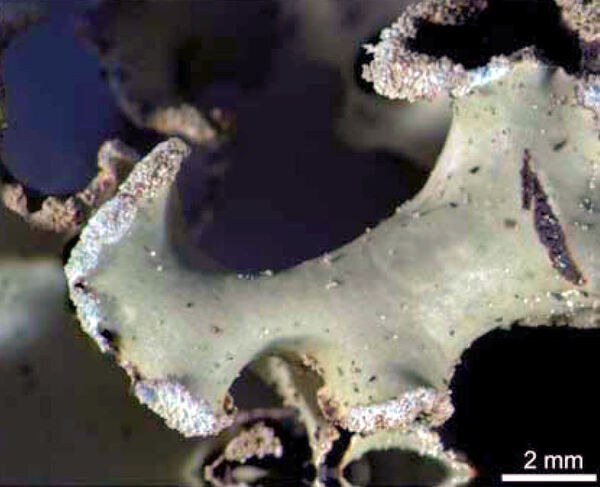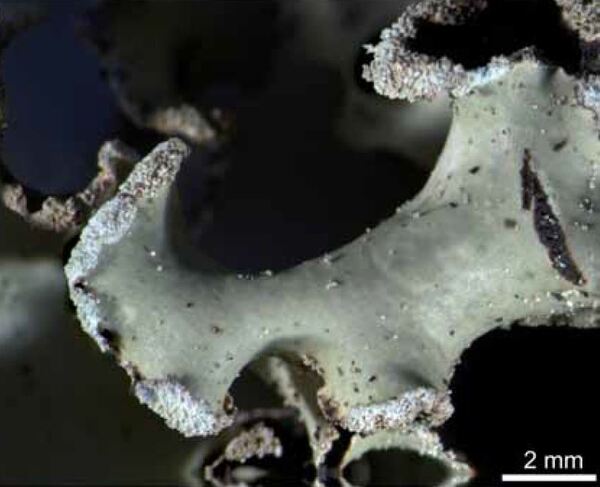Cetrelia monachorum (Zahlbr.) W.L. Culb. & C.F. Culb.
Syst. Bot., 1: 326, 1977 (1976). Basionym: Parmelia monachorum Zahlbr. in Handel-Mazzetti - Symb. Sinic., 3: 180, 1930.
Synonyms:
Distribution: N - Frl (Obermayer & Mayrhofer 2007), Ven (Nascimbene & al. 2021), TAA (Obermayer & Mayrhofer 2007, Nascimbene 2014, Nascimbene & Marini 2015, Trindade & al. 2021, Nascimbene & al. 2022), Lig (Ravera & al. 2019b). C - Sar (Nascimbene & al. 2021).
Description: Thallus foliose, heteromerous, dorsiventral, loosely attached, forming wavy, wide-spreading, usually orbicular, 6-20(-40) cm wide rosettes. Lobes broad and rotund, (0.5-)1-1.5(-2) cm wide, with raised margins, greenish grey (sometimes tinged brown), pseudocyphellate; pseudocyphellae on upper surface frequently developing on slightly raised structures, often appearing as accumulation of individuals to form a larger unit, sometimes lacking in the central parts of older thalli, those on the lower surface usually absent (but sometimes sparingly developed). Soralia primarily marginal, often rather irregularly shaped, with coarse soredia measuring (35-)40-55 µm. Lower surface black, wrinkled, with scattered, simple, black rhizines and a brown, rhizine-free zone along the margin. Upper and lower cortices prosoplectenchymatous, the upper one with a non-pored epicortex, of densely agglutinated hyphae with tiny lumina; medulla white, with isolichenan, I-. Apothecia very rare, lecanorine. Asci 8-spored, Lecanora-type. Ascospores 1-celled, hyaline, ellipsoid, 12-15 x 7-10 µm. Pycnidia: unknown. Photobiont chlorococcoid. Spot tests: cortex K+ (weakly) yellow, C-, KC-, P-; medulla and soralia K+ yellow, C- or C+ faintly pink/violet, KC+ pale pink of pale reddish brown, P-. Chemistry: cortex with atranorin and chloroatranorin (in lower amounts than in soralia); soralia (and medulla) with atranorin, imbricaric acid (major), perlatolic acid (minor or traces), 4-O-demethylimbricaric acid (minor or traces), anziaic acid (traces), an unidentified fatty acid, sometimes with traces of glomelliferic, loxodellic and divaricatic acid.Note: a species with the imbricaric acid syndrome (major) and perlatolic acid (minor), found on the bark of broad-leaved trees, more rarely on silicicolous mosses in humid, old, mostly montane forests; probably the most common species of Cetrelia in Italy (see comment on the genus). It is included in the Italian red list of epiphytic lichens as “Data Deficient” (Nascimbene & al. 2013c).
Growth form: Foliose, broad lobed
Substrata: bark
Photobiont: green algae other than Trentepohlia
Reproductive strategy: mainly asexual, by soredia, or soredia-like structures (e.g. blastidia)
Most common in areas with a humid-warm climate (e.g. most of Tyrrenian Italy)
Commonnes-rarity: (info)
Alpine belt: absent
Subalpine belt: absent
Oromediterranean belt: absent
Montane belt: very rare
Submediterranean belt: extremely rare
Padanian area: absent
Humid submediterranean belt: absent
Humid mediterranean belt: absent
Dry mediterranean belt: absent

Predictive model
Herbarium samples
Growth form: Foliose, broad lobed
Substrata: bark
Photobiont: green algae other than Trentepohlia
Reproductive strategy: mainly asexual, by soredia, or soredia-like structures (e.g. blastidia)
Most common in areas with a humid-warm climate (e.g. most of Tyrrenian Italy)
Commonnes-rarity: (info)
Alpine belt: absent
Subalpine belt: absent
Oromediterranean belt: absent
Montane belt: very rare
Submediterranean belt: extremely rare
Padanian area: absent
Humid submediterranean belt: absent
Humid mediterranean belt: absent
Dry mediterranean belt: absent

Predictive model
| Herbarium samples |
 Index Fungorum
Index Fungorum
 GBIF
GBIF



